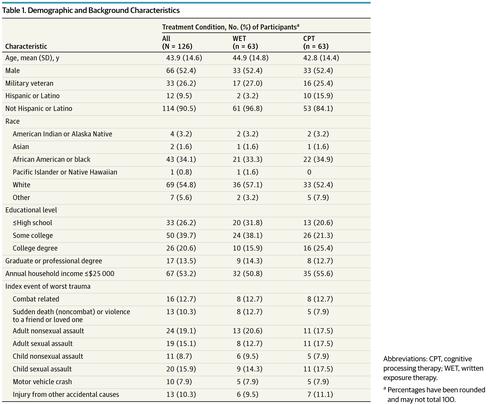JAMA Psychiatry ( IF 22.5 ) Pub Date : 2018-03-01 , DOI: 10.1001/jamapsychiatry.2017.4249 Denise M Sloan 1, 2 , Brian P Marx 1, 2 , Daniel J Lee 1 , Patricia A Resick 3

|
Importance Written exposure therapy (WET), a 5-session intervention, has been shown to efficaciously treat posttraumatic stress disorder (PTSD). However, this treatment has not yet been directly compared with a first-line PTSD treatment such as cognitive processing therapy (CPT).
Objective To determine if WET is noninferior to CPT in patients with PTSD.
Design, Setting, and Participants In this randomized clinical trial conducted at a Veterans Affairs medical facility between February 28, 2013, and November 6, 2016, 126 veteran and nonveteran adults were randomized to either WET or CPT. Inclusion criteria were a primary diagnosis of PTSD and stable medication therapy. Exclusion criteria included current psychotherapy for PTSD, high risk of suicide, diagnosis of psychosis, and unstable bipolar illness. Analysis was performed on an intent-to-treat basis.
Interventions Participants assigned to CPT (n = 63) received 12 sessions and participants assigned to WET (n = 63) received 5 sessions. The CPT protocol that includes written accounts was delivered individually in 60-minute weekly sessions. The first WET session requires 60 minutes while the remaining 4 sessions require 40 minutes.
Main Outcomes and Measures The primary outcome was the total score on the Clinician-Administered PTSD Scale for DSM-5; noninferiority was defined by a score of 10 points. Blinded evaluations were conducted at baseline and 6, 12, 24, and 36 weeks after the first treatment session. Treatment dropout was also examined.
Results For the 126 participants (66 men and 60 women; mean [SD] age, 43.9 [14.6] years), improvements in PTSD symptoms in the WET condition were noninferior to improvements in the CPT condition at each of the assessment periods. The largest difference between treatments was observed at the 24-week assessment (mean difference, 4.31 points; 95% CI, –1.37 to 9.99). There were significantly fewer dropouts in the WET vs CPT condition (4 [6.4%] vs 25 [39.7%]; χ21 = 12.84, Cramer V = 0.40).
Conclusions and Relevance Although WET involves fewer sessions, it was noninferior to CPT in reducing symptoms of PTSD. The findings suggest that WET is an efficacious and efficient PTSD treatment that may reduce attrition and transcend previously observed barriers to PTSD treatment for both patients and providers.
Trial Registration clinicaltrials.gov Identifier: NCT01800773
中文翻译:

创伤后应激障碍的简短暴露治疗与认知加工治疗:随机非劣效性临床试验
重要性书面暴露疗法 (WET) 是一种为期 5 个疗程的干预措施,已被证明可以有效治疗创伤后应激障碍 (PTSD)。然而,这种治疗方法尚未与一线 PTSD 治疗方法(如认知处理疗法 (CPT))进行直接比较。
目的确定对于 PTSD 患者,WET 是否不劣于 CPT。
设计、设置和参与者在这项于 2013 年 2 月 28 日至 2016 年 11 月 6 日在退伍军人事务医疗机构进行的随机临床试验中,126 名退伍军人和非退伍成人被随机分配接受 WET 或 CPT。纳入标准是 PTSD 的初步诊断和稳定的药物治疗。排除标准包括当前针对 PTSD 的心理治疗、自杀高风险、精神病诊断和不稳定的双相情感障碍。分析是在意向治疗的基础上进行的。
干预措施分配到 CPT 的参与者 (n = 63) 接受了 12 次会议,分配到 WET 的参与者 (n = 63) 接受了 5 次会议。包含书面记录的 CPT 协议是在每周 60 分钟的会议中单独交付的。第一节 WET 需要 60 分钟,其余 4 节需要 40 分钟。
主要结果和措施主要结果是DSM-5临床医生管理的 PTSD 量表的总分;非劣效性的定义为 10 分。在基线以及第一次治疗后 6、12、24 和 36 周进行盲法评估。还检查了治疗退出情况。
结果对于 126 名参与者(66 名男性和 60 名女性;平均 [SD] 年龄,43.9 [14.6] 岁)来说,在每个评估周期,WET 条件下 PTSD 症状的改善并不逊色于 CPT 条件的改善。治疗之间的最大差异是在 24 周评估时观察到的(平均差异,4.31 分;95% CI,–1.37 至 9.99)。 WET 与 CPT 条件下的脱落率明显较低(4 [6.4%] vs 25 [39.7%];χ 2 1 = 12.84,Cramer V = 0.40)。
结论和相关性尽管 WET 涉及的疗程较少,但它在减少 PTSD 症状方面并不逊色于 CPT。研究结果表明,WET 是一种有效且高效的 PTSD 治疗方法,可以减少患者和提供者的损耗并超越之前观察到的 PTSD 治疗障碍。
试验注册ClinicalTrials.gov 标识符:NCT01800773











































 京公网安备 11010802027423号
京公网安备 11010802027423号